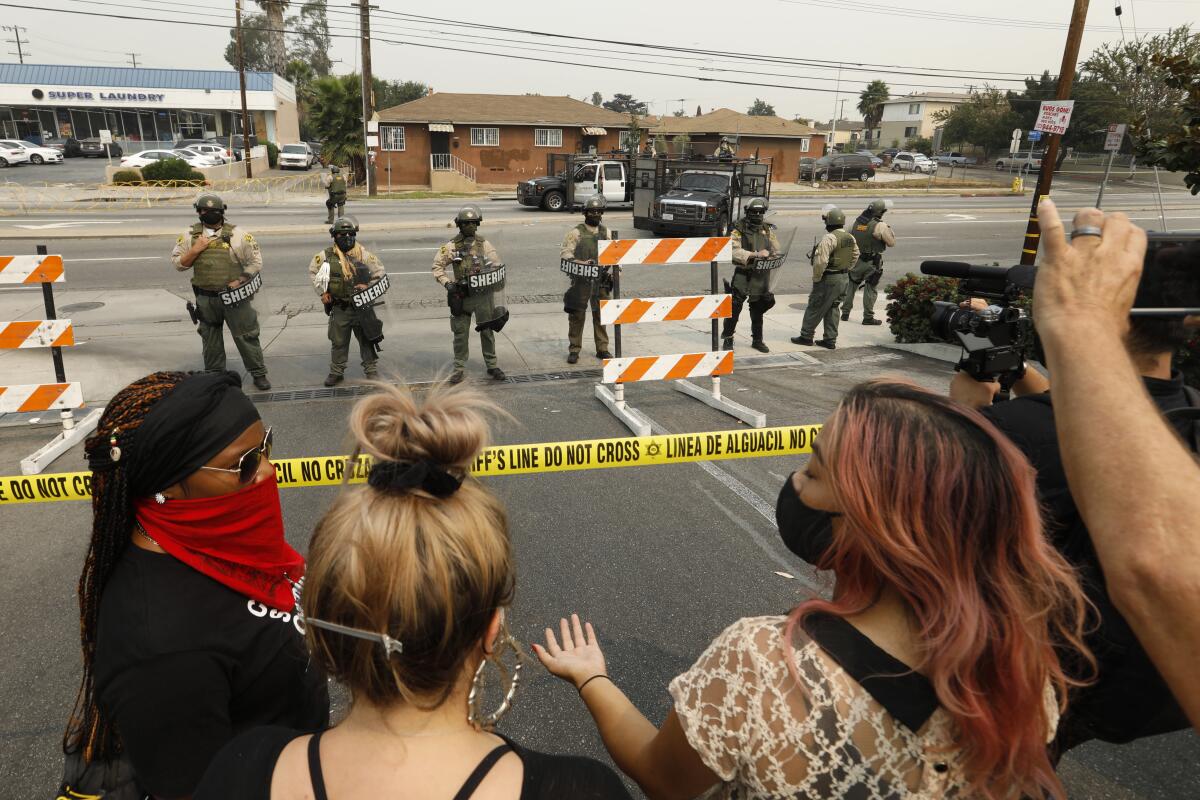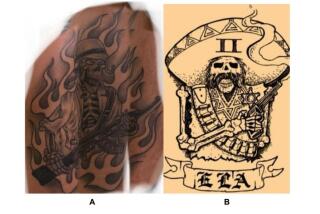L.A. County sheriff says deputies can conceal their names during protests

- Share via
Los Angeles County Sheriff Alex Villanueva has authorized his deputies to conceal their names while policing protests and other civil disturbances.
Villanueva said Wednesday that the change to the department’s long-standing practice of requiring deputies to wear tags engraved with their last names on their uniform shirts was in response to recent incidents in which deputies were harassed and had personal information revealed by protesters.
The details of the new rule are still being worked out but will leave it to deputies to choose whether to cover their name tag, a department spokesman said. Those who choose to do so will be identifiable through their badge numbers, the spokesman said.
The change came after a protest last week outside Men’s Central Jail at which several deputies were filmed with duct tape covering their name tags. The move troubled activists and department watchdogs, who said such obfuscation made it much harder to hold deputies accountable and fueled distrust among communities demanding greater transparency and reforms by police agencies. Some said replacing deputies’ names with a number will make it harder to identify deputies who they accuse of abusive conduct during chaotic situations at protests.
“You should be able to know the name of a deputy who you interact with,” said Sean Kennedy, a law professor who serves on the Sheriff Civilian Oversight Commission. “There’s no way that we can effectively monitor law enforcement if you can’t even get the name of a deputy that you’re interacting with in public who has taken some kind of use of force or action against you.”
State law requires police officers to clearly display either their name or an identification number on their uniforms.
During a live Facebook broadcast Wednesday, Villanueva explained his reasoning, saying protesters have used deputies’ name tags to find their home addresses and spread the information on social media. At times, he said, people have shown up at deputies’ homes and vandalized their property.
“That is not exactly the intent of state law,” Villanueva said.
Villanueva did not provide details of such incidents involving deputies but pledged to prosecute those involved.
He said his own name and address were plastered on banners hung from overpasses on several freeways and on fliers stuck to telephone poles that resembled fugitive wanted posters.
In response to a Times request for details of incidents in which deputies were identified and harassed, a spokesman for the Sheriff’s Department did not give specific examples but said there were “numerous” incidents during protests in which protesters taunted deputies by pulling up social media pages belonging to them while they squared off.
“In several of these instances there were vile and repulsive comments made, as well as implied threats of violence,” Lt. John Satterfield said.
A law enforcement source, who was not authorized to speak on the issue, told The Times that demonstrators flashed photos of the deputies’ relatives and threatened to rape their wives and shoot their family members. Two protesters who have attended many protests said they had not witnessed such conduct.
“That’s absolutely false. Protesters are not doing that… How can they even come up with something like that?” said Traci Carr, 30, who planned the protest outside the jail on Thanksgiving. “It’s just a way of making us look like the bad guys.”
In California, it’s a misdemeanor to post identifying information about someone in order to put them in reasonable fear for their safety and cause them unwanted physical contact or harassment.
Demonstrators over the summer showed up at the home of Deputy Miguel Vega, who shot and killed 18-year-old Andres Guardado in an incident that generated weeks of protests and calls for an independent investigation. Police moved Vega’s family from the home as protesters were “yelling at the residents and posting ‘killer cop lives here,’” according to a brief entry about the incident in a Sheriff’s Department log obtained by The Times. A flier was circulated with Vega’s name and address next to a photo, saying he shot Guardado five times in the back.
Satterfield said the sheriff and his senior aides were unaware that deputies were planning to cover their names during the Thanksgiving event. A supervisor overseeing the deputies gave them the green light to do so and a department inquiry concluded that the actions were reasonable, Satterfield said.
The demonstrators who filmed deputies obscuring their name tags and badges had gathered in support of Emanuel Padilla, a 34-year-old toy designer who has been charged with attempting to wreck a train during a protest this year. Critics have decried the charges, claiming they are trumped up and meant as retaliation against a protester. Padilla is being held at Men’s Central Jail without bail, jail records show.
Carr, the organizer, said about 30 demonstrators were outnumbered by the roughly 50 deputies who policed the event.
“It’s pretty terrifying when you’re trying to have a potluck and then you look up and there’s sheriff’s deputies with rubber bullet guns,” she said.
Several protesters said the deputies, many of whom were carrying launchers that fire foam rounds or riot shields, refused to identify themselves when questioned. In a video provided to The Times, one deputy would identify himself only as “emergency response sergeant one” when asked about the obscured name tags.
Some activists and independent journalists said deputies have been obscuring their names at demonstrations for months, with the problem becoming increasingly noticeable during hostile interactions between protesters and deputies in South L.A. after the fatal deputy shooting of Dijon Kizzee.
“It’s an accountability issue. They are public servants. They are supposedly keeping us safe,” said 32-year-old demonstrator Mary Mattingly, who also attended the Thanksgiving potluck. “If they are covering their badge numbers and they are covering their names … we can’t hold them accountable for anything that they are doing.”
Other police agencies have also changed how deputies identify themselves in the field.
The Beverly Hills Police Department is allowing officers to cover their name tags while assigned to protests. And the Portland Police Bureau in Oregon recently assigned each of its officers a three-digit identification number to wear on their helmets during protests in part due to demonstrators repeatedly staging events at the homes of police officials.
More to Read
Sign up for Essential California
The most important California stories and recommendations in your inbox every morning.
You may occasionally receive promotional content from the Los Angeles Times.












